
It's a Tuesday morning in 2037. You hurriedly brush your teeth and dress to meet the self-driving car arriving downstairs. As it pulls away from the curb, what world awaits? Will you pass children frolicking in lush playgrounds built over now unneeded parking lots? Or lines of homeless ex-truckers waiting for a rare remaining bus, as autonomous luxury RVs carry snoozing techies to work along a new shoreline born of rising seas?
It might not just be cars driving themselves, either. The same technology that lets a Volvo safely navigate a world of stray dogs and road construction can eventually get cheap and small enough to help a walking hors d'oeuvres table thread its way through a crowd. Or a public health microbot navigate the leg hairs of a target in search of louse eggs, after infiltrating his socks.
Self-driving cars may indeed prove the killer app that turns smart navigation into an industry. But the implications of such navigation are far broader, from an internet of moving things to a rethink of nearly every way we transport both objects and ourselves. More than we're consciously aware, transport today is shaped by the attentions spans, comfort, egos, and budgets of human drivers. Once we unravel those links, transport of all kinds will find new centers of gravity, business models, and policy goals. But there may be twists and turns along the way.
In mid 2014 I curated an exhibit on the evolution of autonomous vehicles called Where To? As a temporary exhibit, it was quick to create and meant to last a few months. But the enormous interest in the topic surprised us. Buzz Aldrin, who rode largely autonomous rockets to the Moon in 1969, came to the press opening with Sebastian Thrun, the father of exhibit sponsor Google's self-driving car program. The sustained public curiosity made it our longest-lived temporary exhibit ever—we've finally taken it down after five-and-a-half years. Interested parties can still access the online version of the exhibit, plus added content.
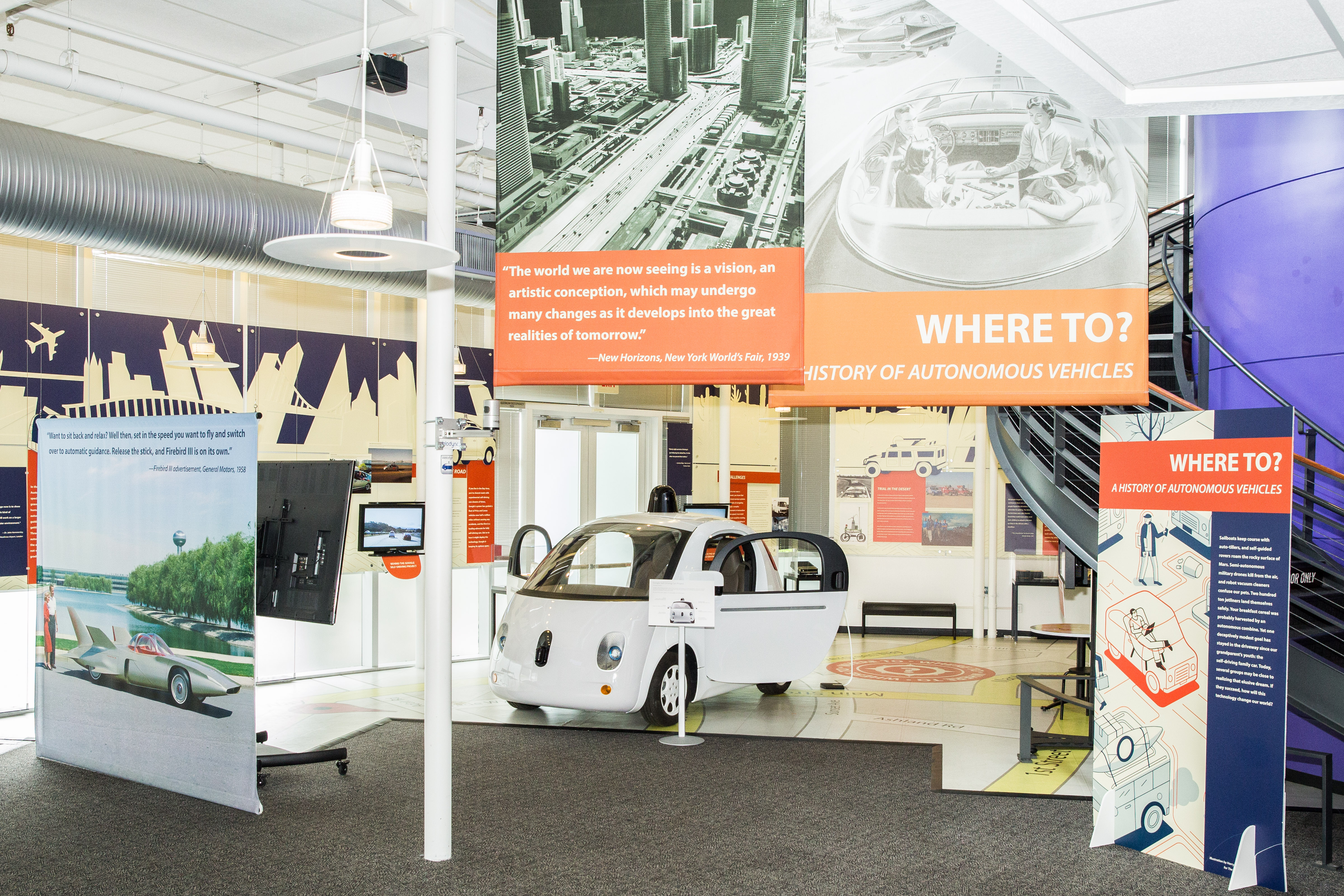
Where To? A History of Autonomous Vehicles, on exhibit at CHM May 9, 2015–December 1, 2019.
Much of that ongoing interest stems from suspense, the simple fact that we still don't know how the story ends. Self-driving cars are an 85-year-old dream still in the process of (probably) becoming real and are jumpstarting a set of technologies with implications far beyond the road.
Back in 2014 autonomy for cars seemed a rather quixotic whim pursued by the ultra-rich founders of Google and a few others. It felt like a solution in search of a problem. Why spend zillions automating a difficult task that most humans not only do surprisingly well, but often enjoy? The use case was far less obvious than for a dishwasher or washing machine. We'll explore some of the motivations below. But the first questions were still technical—how could it work? is it safe?—and historical.
Where To? traced the growing success of autonomous vehicles from the 1860s torpedo to the WWII German V-2 guided missile, which developed into the rockets that carried Aldrin and Armstrong to the Moon. Later autonomous vehicles have explored the deepest oceans, hunted people from the air (drones), left our solar system (Voyager), and harvested our breakfast cereals in the form of self-driving combines.
The exhibit showed the extent to which autonomous vehicles already surround us, from open pit mines to warehouses to hospital corridors, except for the one place we notice most—public roads. That final frontier has remained a dream since the 1930s, when science fiction stories explored the topic and General Motors mocked up an autonomous future at the 1939 World's Fair.
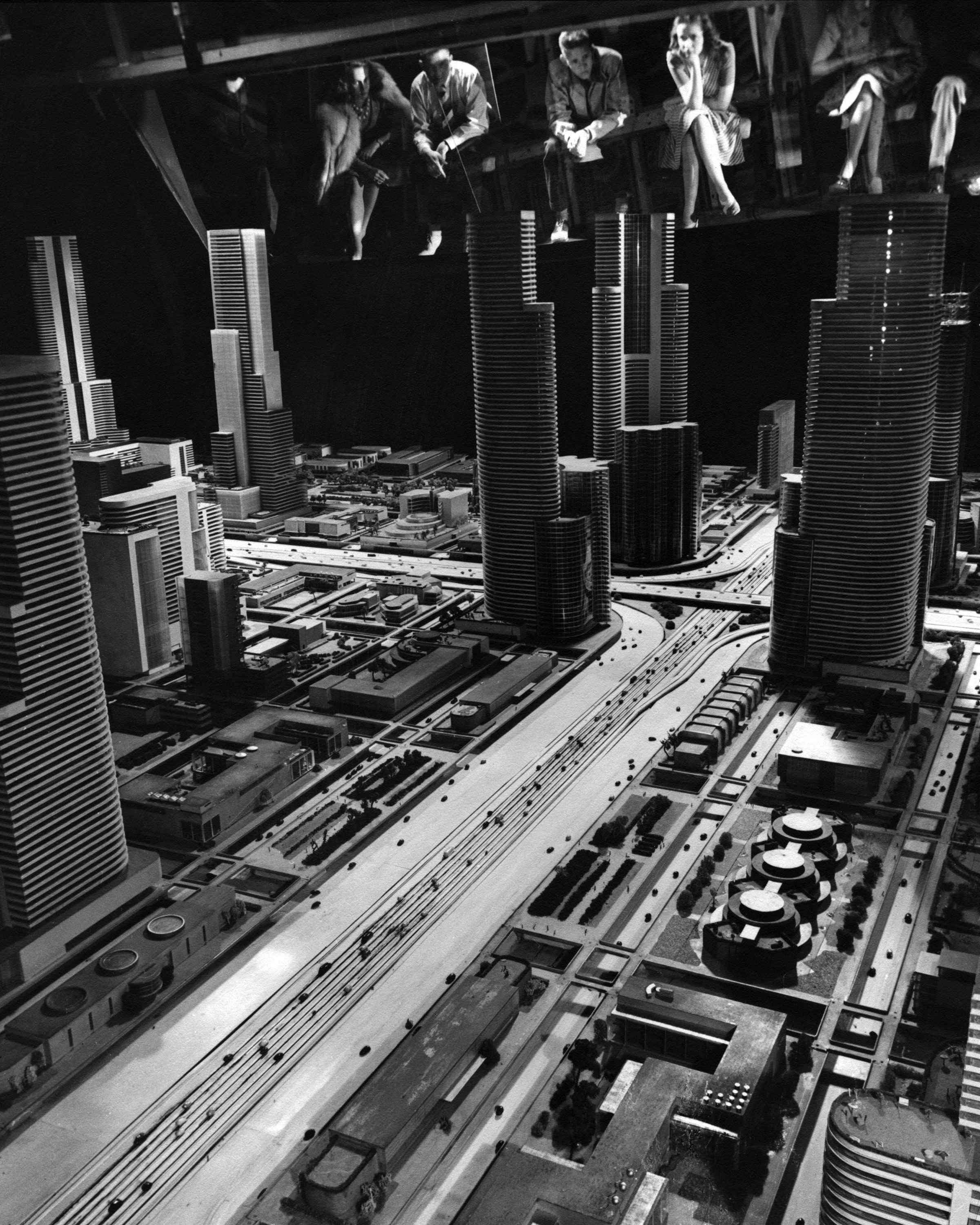
New York World’s Fair, Futurama: Highways & Horizons, 1939. At the time visions of freeways cutting right through city centers were still considered chic and futuristic. Credit: General Motors
Five and half years later, even after several billion dollars of investment combined from over a dozen car and other companies, general-purpose autonomous cars remain over the horizon. If they never arrive, of course, safety and other concerns will be irrelevant. But robocars are looking likely enough that it's time to start asking serious questions how this next revolution might reshape society.
We're standing at the cusp of a change in how people and things move about as great as those facing visionaries in the 1930s, when the truck was freeing farmers from the clutches of railroad monopolies and giant freeways remained mostly a thrilling, utopian dream.
Perhaps even as great as a Tuesday night in 1837, when Charles Wheatstone and William Cooke demo'd the first electrical telegraph as a control system for a new kind of transport startup—a railroad company.

Euston Railway Station, London, showing the original wrought iron roof of 1837. That year, Charles Wheatstone and William Cooke demonstrated the first electrical telegraph between here and the station at Camden Town, as a control system for then-new railroads. Credit: Wikimedia Commons
Our ability to peer over the horizon feels little better than it must have then. In 1837, the press was full of literally hysterical fears of what the speed of trains might do to human health. Some speculated that women's uteruses might be dislocated from the motion or that passengers would be unable to breathe. The belief that a train's speed and motion could drive men temporarily insane persisted for decades. Some of today's fears around self-driving may look as odd in retrospect. Or as rational as another 1830s fear, boiler explosions. The telegraph wasn't always better understood; a contemporary article described a customer asking to send sauerkraut to a soldier at war over the telegraph wires.
Back then there was no precedent for guessing how mechanized transport and light-speed information nets might transform a world where little had ever moved faster than a horse. 1930s visions had considerably more to go on both for the automobile and for the dream of making automobiles self-guiding like trains. Designers like Norman Bel Geddes drew freeways cutting proudly through city centers in a way reminiscent of Fritz Lang's film Metropolis, sometimes—as at Futurama—with unpiloted vehicles rolling on self-guiding highways. Real freeways had been pioneered by Mussolini's autostrada system. Sears had knitted together transport and information technology into a delivery network that puts Amazon to shame.
The first science fiction story we could find that talks about self-driving, neuropsychiatrist David Keller's 1935 "The Living Machine," started off with a vision whose main points could be lifted from a Waymo marketing piece:
Old people began to cross the continent in their own cars. Young people found the driverless car admirable for petting. The blind for the first time were safe. Parents found they could more safely send their children to school in the new car than in the old cars with a chauffeur.
But it turned darker when the cars began hunting pedestrians and purposefully crashing to kill their own passengers. The reason was an especially pulp 1930s touch—traces of cocaine in their gasoline had driven them insane.
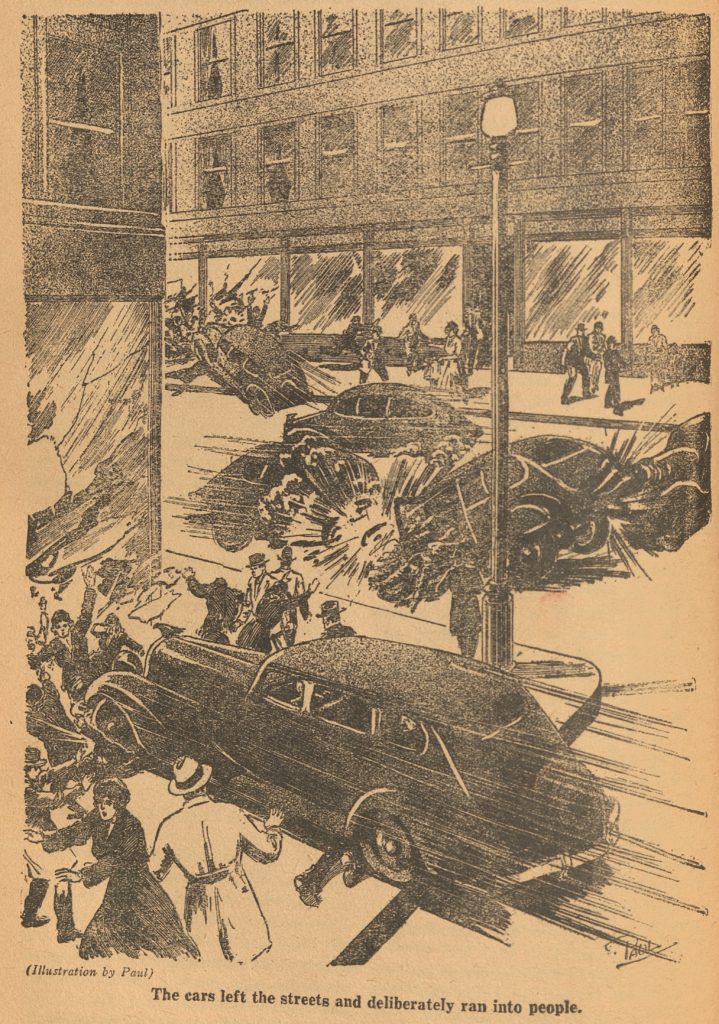
Illustration by Frank R. Paul for "The Living Machine" by David H. Keller, the first story we could identify that talks about autonomous cars. In Wonder Stories, May 1935. Continental Publications, edited by Hugo Gernsback.
Today, if we put our thinking caps on right, we can try to learn from a nearly 200-year mingling of telecom, automation, and mechanized transport. One lesson is that not all effects are predictable, like the greatest unintended consequence of them all—climate change.
A more recent revolution in moving things around, the web and internet, has shown how small early decisions can make even the most promising technology go partly awry. Like a mischievous genie, reality has a way of turning the loveliest, purest wishes into very mixed results. The best we can do is try to anticipate some of the genie's more obvious moves in advance.
So as you cruise along on that Tuesday morning in 2037, what might self-driving really look like? The dozens of companies trying to make it commonplace assure us you'll be rolling through a green paradise. They point out that because today's private cars sit idle more than 95 percent of the time, replacing them with a few shared, energy sipping robocars will free up former street parking spaces to become bike paths and parklets. The community gardens you pass will be ex parking garages. There will be far less congestion, of course, and little pollution as silent electric flitters whisk us from place to place, the air clear and blue above playgrounds thick with sunshine and butterflies.
In this world, a child can chase an errant ball with little fear of being mowed down. Hospitals will be smaller and sleepier places, freed of the tragic burden of over four million yearly emergency room visits from car accident in the US alone. But on the rare occasion that a citizen needs emergency care, say for a serious gardening injury, the response will be seamless. If no airlift is available, the few vehicles on the streets will automatically make way for the ambulance as traffic lights turn from red to green, alerted by the wireless network that connects all cars. Out on the freeways "road trains" of electric robotrucks spaced evenly nose to tail will flexibly carry our impulse purchases with nearly the energy efficiency of real trains.
But perhaps when you round the corner, things have not turned out so egalitarian. It's worth noting that the dreams above are meant to be reassuring, much as early cars looked like and were marketed as friendly "horseless carriages" rather than harbingers of unstoppable change. Or the way the massive neoclassical arch at the entrance to Euston train station framed the era’s bleeding-edge tech of steam and iron in the reassuring grandeur of the past.
The green dreams for self-driving don't make it obvious why a dozen companies including carmakers are investing serious sums in the technology. Even if you take those companies' public answer at face value—that they want to save a million lives a year lost to road accidents—this number might be more cheaply and directly pursued by funding, say, better access to vaccines. Or by beefing up road safety programs in developing countries with high accident rates.
That's not to deny the passion of key people working on the topic. Some have lost close friends to accidents and being in a position to potentially save millions of lives through your work is a rare blessing. But it strains credulity that some of the same carmakers that bitterly resisted seat belts and collapsible steering columns (that prevent impaling drivers through the chest) have chosen self-driving as a way to finally atone.
Some of the green arguments, too, at first seem to require a certain cognitive dissonance. In order to reduce the world's vast use of carbon-emitting personal vehicles, we should teach every one of those vehicles to . . . drive itself, which can also free it to drive empty on any number of errands or circle the block with an advertising banner. Even the greenest scenario—where people carpool and share use of private cars—doesn't actually seem to require self-driving. BlaBlaCar and Getaround are two apps that let you do those things today.
If you follow the arguments of the self-driving faithful through to the end, however, everything makes sense. Though parts of the vision require the kind of nerdish faith in logic that animated the early web community—that because something is possible and should happen, it will. But even if you are considerably more cynical there are a lot of very real, very good things that can potentially come out of the driverless revolution.
The simplest part of the answer to "why self-driving?," of course, is the estimated $7 trillion annually to be made directly from revolutionizing the ground transport industry. The other part is all the knock-on applications for the technology, from delivery drones that can safely navigate around crowds to intelligent lawnmowers.
Suppose as you get on the main road you're passed with a whoosh by a limo carrying startup CEO Andin, who is paying a thick premium to force cars out of his way almost as if he were an ambulance. He wishes VTOL flying cars were allowed in this part of town. AramCoins hemorrhage invisibly from his corporation's account to fatten the wallet of FastTrak Platinum through the AutoNet. He's late for a stockholder meeting. As he reclines in the buttery leather owner's chair of the Tesla Olympus Mons, he's editing his talking points on the big screen in front of him. He wonders for the dozenth time whether he should have followed the Feng Shui consultant's recommendation to orient the screen toward the left. Not only does it block the Matisse, but sitting sideways makes even mild braking uncomfortable.
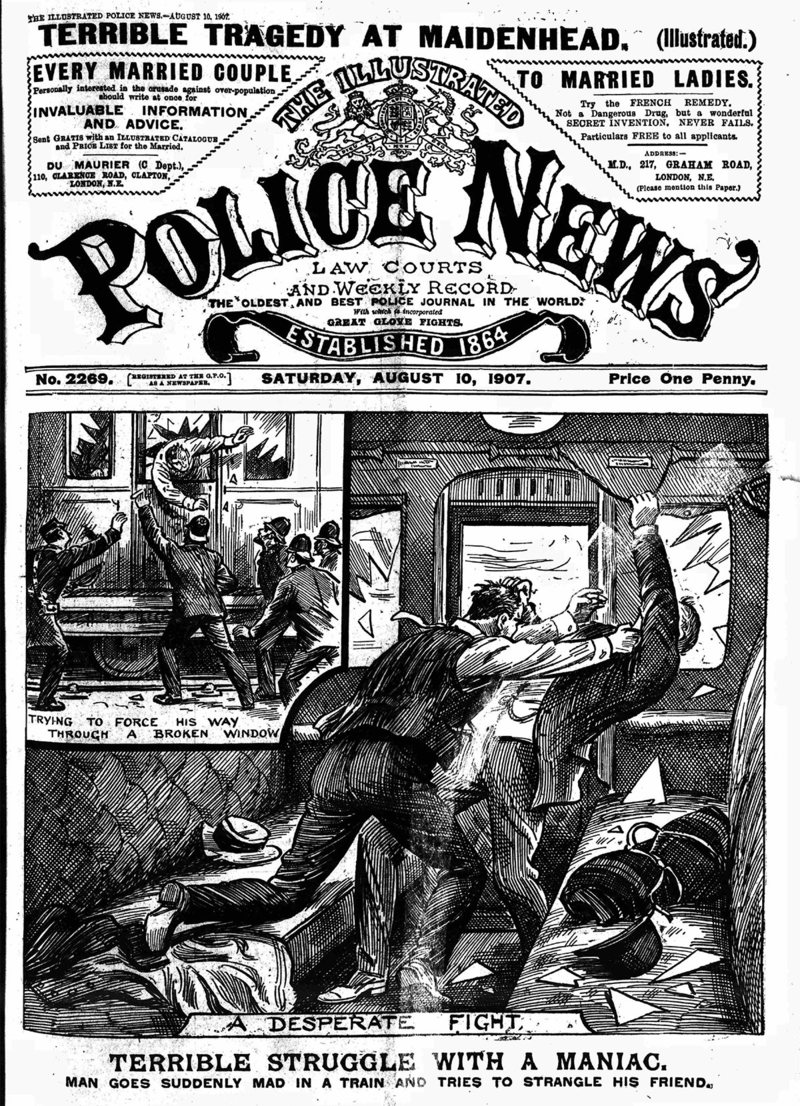
Misconceptions about new technologies are nothing new. The common Victorian belief that a train ride could cause instant, temporary insanity persisted even into the 20th century. Illustrated Police News, Saturday, 10 August 1904. Newspaper image © The British Library Board. All rights reserved. With thanks to The British Newspaper Archive (www.britishnewspaperarchive.co.uk).
Without glancing out the window Andin passes Jorge, a retired Lyft driver waiting in line for one of the remaining public buses. He's hoping it's not too full of tents to find a place. His social credit score isn't high enough to let him ride in one of the community shuttles provided by Googazon since the merger. He's still trying to clear it of an old ticket for rolling through a stop sign, when human driving was still allowed at night.
Just down the road Elona is trying to sneak onto a short stretch of driverless road in their parent's old manual Volt to avoid a two hour detour on the few remaining all-purpose roads. Registration fees for manual driving have been rising like crazy, but are still far cheaper than a new car. But no luck. The flashing lights of the police drone fill the windshield as they hurriedly dump their last few microdoses of gluten out the rust hole in the floorboards.
For some, this Tuesday morning didn't start at home. Cornelia is dreaming of waves when she gently stirs and starts to wake up. The big Waymo RV must have hit a bump even the smart suspension can't fully damp out. She prays it’s not the remains of another homeless encampment on the shoulder, where the screens shows her the Waymo was trying to route around a broken down Apple iRoll. There's always a risk somebody was inside a flattened tent.
She'd gone to bed early after putting the kids to bed at her mom's in Redding. But now she's only at Vacaville, on her way to the office in Mountain View. Smarter cars can't change the fact that too many people are doing night commutes from the affordable upper Central Valley. What used to be two hours at 120 mph can now be eight or more. She'll have to join the meeting via telepresence from the road. As she sits up and stretches she tries connecting to Robin with her brain-computer interface but just gets static. Maybe her therapist is right, they aren't on the same wavelength.
We can imagine dozens more scenarios both likely and not, from the potent results of combining self-driving with hookup apps, to an old man walking blocks to get around a smart intersection where cars whiz seemingly through each other's paths—like a living cloth woven of speeding vehicles—at over 60 miles an hour.

Concept video showing smart intersection where cars don't stop but pass between each other, coordinated by the self-driving network. "Shanghai 2030" video, General Motors
I personally think some of the issues to watch are around the fine-grained control of people's movements, like the scenario where Jorge can't ride a shuttle because his social credit score is too low, or perhaps welfare recipients not being allowed to spend income on "frivolous" trips.
In Western democracies we tend to take freedom of movement for granted. But many countries require internal visas for travel and especially immigration between regions. Self-driving combined with digital payment systems could bring such controls down to the micro level. Governments might use them to make public assembly more difficult or even enforce an electronic apartheid against certain ethnic groups. Of course, other restrictions might have broad and justified support, like using smart transport to automatically enforce a restraining order against an abusive spouse. But all would bring up new questions about civil liberties.
Another sensitive area is public transport. In theory, self-driving can vastly expand its reach in rural and under-served areas. Autonomous public vans and shuttles can affordably cover routes that would be prohibitive today. Vehicles could be sized to actual demand, rather than running huge standard buses which are empty much of the time.
But without the right framework it's just as easy to imagine a scenario more like San Francisco today, where Uber, Lyft, and corporate shuttles steadily lure better-heeled passengers out of public transport, widening the social divide. Self-driving optimists assure us the roboshuttles will be cheaper than buses, serving everybody. Even if that's eventually true, the transition period could be a rough ride.
In the early phases of self-driving, even the most hopeful concede that congestion might go up, rather than down. Self-driving may also speed the current "retail apocalypse," as stores are emptied out by the convenience of online ordering.
There is another set of questions about what passengers want, i.e. what ordinary people would like to use self-driving for. When we posed options to some of our visitors in a small survey, "Apply makeup, shave, or catch some last-minute zzz’s during your commute to work" came first, followed by making a car the designated driver for a night on the town. Others wrote in to chauffeur their aging parents after they took the car keys away, or to avoid the stress of night driving.
The desire to sleep or put on makeup shows a potential flaw in the shared robotaxi model assumed by many self-driving companies. Illustrations of the self-driving future tend to show something like first-class air travel, with well-dressed people playing games or working on screens in sleek interiors with generous legroom. But as people begin to do more and more non-driving things in their cars, won't they increasingly want a more personal space? Do you plan to cut your toenails in front of a stranger, or sleep long stretches in your clothes? One egalitarian solution is to divide robotaxis into little compartments, like first class seats on some planes. But both Andin in his limo and Cornelia in her RV are projections of where self-driving might just as easily go—toward rock star tour buses than lightweight pods. Especially when you no longer need to park or maneuver the great beasts.
So which of this wild mix of scenarios is most likely to come true? Perhaps all of them. Only not in the same place, or the same time. Just as the automobile was deployed in very different ways by different cities and regions, the world of robodriving will share global commonalities, but have local models. For instance, freeways in Germany and the Western USA are free and used by all. In Italy and France their steep tolls make them a high road for the rich. Varying regulations make bike and scooter sharing schemes wildly different city to city. The early years of self-driving, especially, may be a Cambrian explosion of different models, before best practices—or influential monopolies—emerge.
We can also imagine lovely, green, walkable scenarios beyond those commonly proposed by the self-driving firms. A number depend on the spread of self-driving passenger vehicles, to the many self-driving things that will not be cars at all.
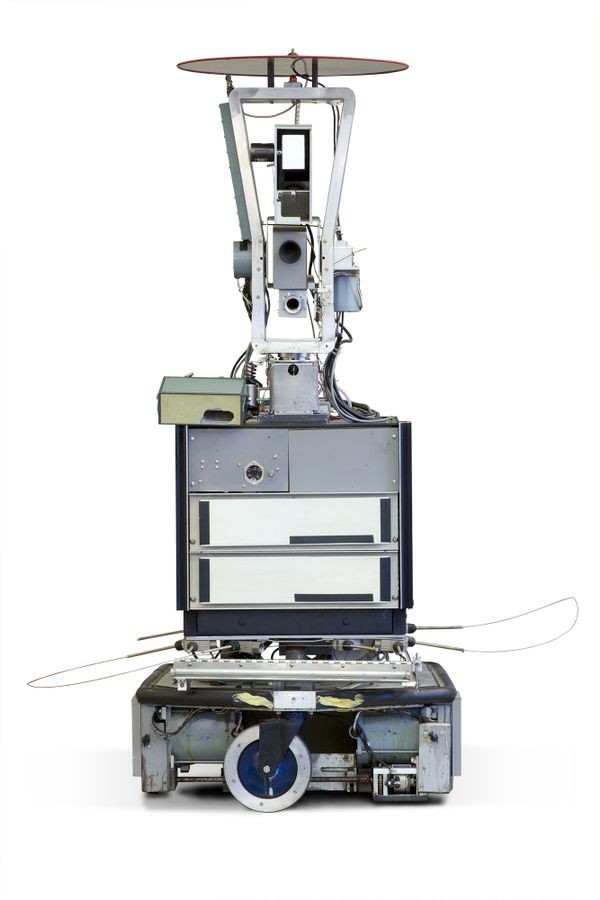
Shakey the robot, "grandfather" of self-driving cars. Along with the Stanford Artificial Intelligence Laboratory Cart, Shakey at SRI pioneered techniques for navigating through an unfamiliar environment with artificial intelligence and machine vision. Photo © Mark Richards
As Where To? pointed out, self-driving vehicles have surrounded us for decades. We just haven't noticed, since they're not passenger cars. But within the industry the connections are clear. Just look at the work history of the woman who led engineering for the Waymo Firefly robocar CHM currently has on display in its lobby. Jaime Waydo's prior job was 12 years leading the mechanical design of Mars rovers for the NASA and the Jet Propulsion Laboratory. Robodriving is even in her family. She told me that her parents, like most large-scale farmers, have used self-driving harvesters, tractors, and other major equipment for years.
Harvesters, extraterrestrial rovers, drones, and robot forklifts have only to deal with relatively static or controlled environments. Mars has few pedestrians. That's how these vehicles can function with only modest smarts or on premade tracks, and in the case of rovers, frequent human intervention.
Safely carrying our loved ones at high speed between cars, buildings and other litigious humans is a different class of problem. If we solve it, we will have made a number of practical breakthroughs that involve key areas of AI—machine vision with real time interpretation, human behavior modeling, machine learning with training, and more—with applications far, far beyond the automotive industry.
This broader promise was further impressed on me when we gave a tour of our permanent Revolution exhibition to Sebastian Thrun, father of Google's self-driving car efforts, and his successor Chris Urmson. Both men had been finalists in the DARPA grand challenge that kicked off modern self-driving technology. And both nearly fell to their knees in homage when I showed them Shakey, the icon of our AI and Robotics gallery, and the Stanford Cart. These 1960s robots were two of the very first to be built to navigate an unfamiliar environment. I realized that however passionate Thrun and Urmson may be about making self-driving safe and real, for them it is just one key application of far broader goals in AI. Self-driving cars are a form of robot. Making them work well is a problem in artificial intelligence.
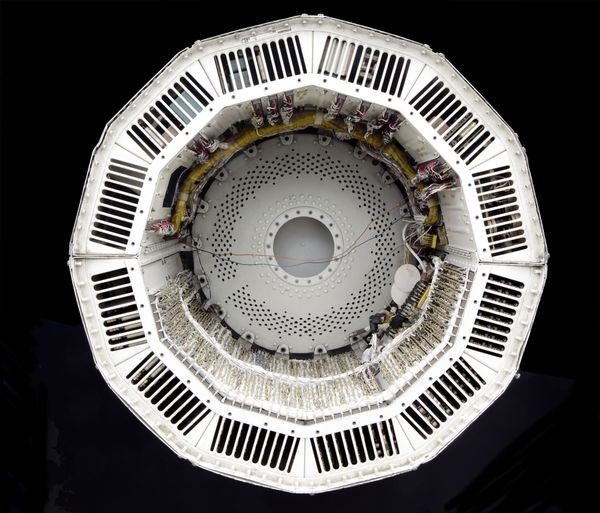
Minuteman Missile Guidance Computer, c. 1960. Among the first autonomous vehicles to use digital computers for control were nuclear-tipped missiles. Computer History Museum/Photograph © Mark Richards
This is all a long-winded way to explain that not all the things driving themselves that Tuesday morning in 2037 or beyond need have humans inside. Or look like cars, or be car-size. Not by a long shot.
Imagine that between Andin in his speeding limo and Jorge waiting for the bus, a wide local freight lane occupies the area formerly taken up by street parking or the soft shoulder. Long distance freight still travels by train or robotruck. But as he waits, Jorge is passed by a clanking mini-excavator on its way to a job site, an oversize house trailer with flashing lights, parts of a pop-up restaurant, several pizzabots, and a pile of smallish packages rolling by at jogging speed under the solar awning of a smart UPS dolly. The dolly's delivery drones buzz away carrying individual packages with the agility of birds. Traffic is even heavier at night when freight rates are lowest.
Now, three kids on hacked auto hoverboards weave in and out of the moving goods at inhuman speed, nearly brushing the edges of rolling stock of every kind and whooping as music blares from their backpacks. An old man with a wispy goatee and stretchmarked tattoos curses them out from his old brakeless fixie bicycle, the only nonautomated vehicle in the lane.
Off the road entirely, a headless "mule" packbot is walking gingerly down a large pile of soft redwood chips, having scooped up a load. The mule's chassis is a direct descendant of the Boston Dynamics walking robots that terrified a generation of YouTube viewers in the 2010s with their eerily agile antics. But now mated with the kind of serious navigation skills once reserved for self-driving cars. It can lope through a crowd. Safely cross a traffic-filled street. And still climb stairs.
Andin is too busy with his PowerPoint to notice the minidrone that splats on his windshield, tiny rotors and legs still whirring in a spastic two-step. Unlike its bigger brethren it was designed to be cheap, not infallible. This one will never pollinate an almond crop or stuff a hornet's nest with anti-breeding pheromones. But thousands of others will.

Whoa, Nelly! Boston Dynamics, Legged Squad Support System Robot prototype for DARPA, 2012. Around the size of a horse. Credit: Wikimedia Commons
It's a lucky accident that the way our nervous systems developed for guiding our bodies through trees and crowds happens to comfortably scale up to controlling huge motor vehicles moving at enormous speed. It even works in three dimensions—airplanes.
Over the past century the automotive industry has fitted its products to our native abilities as closely as a shoe to a human foot. Motor vehicles augment us in as physical a manner as a suit of armor, an excavator's shovel, or a fighting cock's spurs. But the luck may hold in reverse. If researchers can finally manage the hard task of giving a car the ability to drive itself safely, it means they will have given it a general set of navigation skills that partly imitate our own; skills that can move it through all sorts of environments. (That still won't make cars especially smart in general terms. Cockroaches are far better at "driving" themselves than any car on the near horizon).
They could also apply such skills to various machines besides cars, from nanobots to movable buildings. How quickly depends on a version of Moore's Law, that is, that self-driving tech will get cheaper and smaller as it finds more markets. Since we opened Where To? key sensors like LIDAR have dropped in both size and price by an order of magnitude, as have dedicated self-driving computers.
Giving more ordinary machines better vision and navigation abilities can seem prosaic, if still useful—apparently a not uncommon Roomba problem is the machine spreading pet poop over the entire carpet. The importance of good driving may be easier to understand in the negative. Without such skills AI and especially robotics will remain fundamentally limited, restricted to controlled environments and specialized applications, despite other advances. There's a reason the ability to move around reliably is nearly universal across the animal kingdom.
If full self-driving gets cheap, some of the first candidates for liberation could be the simple autonomous vehicles currently used in closed environments—hospital carts, farm equipment, mining trucks, forklifts, and so on. Drones, too, get by today with primitive autonomy, because the air is generally emptier than the ground. But if they get more common and deliver things closer to people, drones will need better smarts.

Coming to a street near you? La Contessa, galleon vehicle at Burning Man, 2005. By Neil Girling, Creative Commons license
From there the possibilities open up. Huge burning man-style galleons cruising down suburban streets for a hired event as other self-driving vehicles move aside to give them room? Lawnmowers doing the rounds of a neighborhood on their own, or pop-up restaurants assembled from modular parts that drive themselves to the next destination?
Feel free to submit your own ideas in our Comments section.
Like self-driving, the Internet of Things can sometimes seem a solution in search of a problem. Visionaries and VCs alike have struggled for decades to explain why you need your toaster or fridge to be online. But the value proposition is clearer for anything that starts moving about. First, current self-driving technology needs access to maps and other online data to compensate for its own limited artificial intelligence. Second, a lot of the magic comes when autonomous vehicles are networked together, as we've seen in several examples. There may be solid reasons for an Internet of Moving Things.
That net could even extend to items which are not autonomous vehicles, but which they might encounter. For instance, why not have your cat's collar or chip identify it as a cat to the network, rather than leave that up to the paint sprayer's computer vision to figure out in real time?
We are the biggest constraint on vehicle design. Today's vehicles move us quickly because we're impatient. They're powerful because that makes us feel powerful, as well as giving us a physical thrill. They are some of the most designed and decorated machines in the world, because they are a public expression of our status and taste. They have windows in certain places so we can see, are roughly rectangular to make them predictable to maneuver and park, and the front seats always face forward, which is also away from other passengers.
The vast majority of them are cars or SUVs, a kind of all-purpose vehicle designed to be the only one a family need own. Cars are a workable compromise on a long series of tradeoffs: big enough for five people but small enough to maneuver and park, somewhat affordable, fast enough for the freeway with enough fuel for at least 350 miles, comfortable and quiet yet not too heavy decent mileage and handling, and so on. Being all-purpose means cars can't be optimized for any of them.
Self-driving can potentially unravel any of these constraints. As we've seen, some of the results might be anything but green or livable. But the potential is just as great on the other side. There are a couple of obvious savings, some of which are already touted by self-driving car companies. Much energy in transport is wasted on being constantly ready to give the human driver a fleeting experience of power at any time. Powerful engines reassure the driver that a press on the pedal will have the car respond like a tiger. (Electric car makers like Tesla compete with fueled cars partly by making their models even more wildly fast).
Being a passenger is different. Do you care if your subway car can do 0 to 60 in five seconds? Generally, no. In fact it would be uncomfortable if it did. Many vehicles today also sacrifice efficiency to feel "drivable." For instance long hoods on trucks and vans make them drive in a more car-like way, but waste interior space.
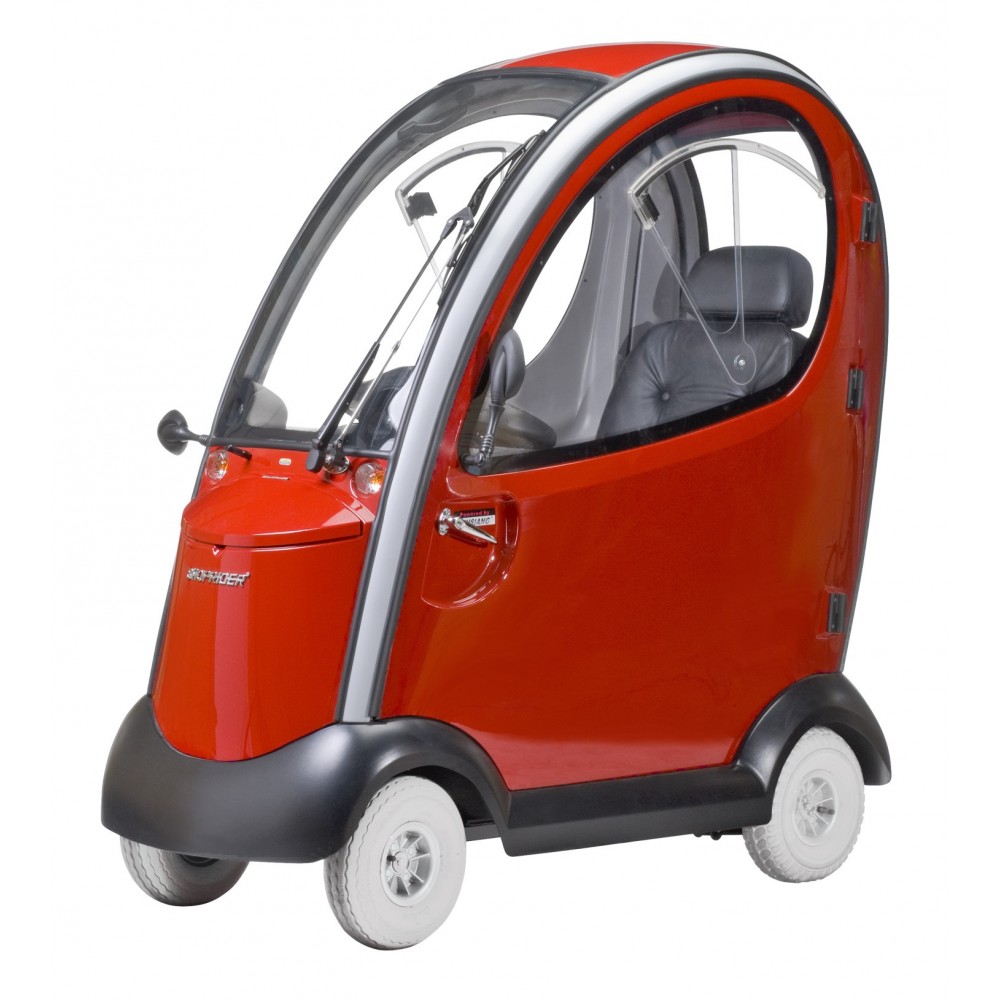
The shape of cars to come? This image is of a current production one-person vehicle that still requires a human driver. Shoprider Flagship 4-Wheel Cabin Scooter. American Quality Health Products
Equally important can be anything that erodes the current norm of a one-size-fits-all vehicle for individual ownership and use. While theoretically smartphones can let us share cars just fine today, with car sharing apps like Getaround and carpooling apps like BlaBlaCar or now Waze, the logistics are a lot tougher. Human carpooling almost always forces either driver or passenger to go somewhat out of their way, or make multiple connections. Car sharing requires the sharer to get to where the car is, rather than vice versa.
Self-driving can smooth over both. Let's imagine your Tuesday drive in 2037 is in a world where both sharing and pooling have taken off. The car at your house had dropped off the last passenger ten minutes before and come to you on the cheaper, slower freight route. The car itself might be owned by a company, a city if it's part of the public transport fleet, or by an individual renting it out when not in use – your ride app can draw from all three.
Shared cars permit specialization. Because you're going on a shortish hop you reserved a tiny one person flivver, a convertible. But later you'll choose a bigger car to go home with your son after school. For next weekend's outing with relatives you'll take a minibus. For an Alaska vacation you might choose an all-wheel drive camping van, or for a thrilling date a self-driving motorcycle or ultralight plane. Because you'll only use many of these vehicles for shortish trips, they don't need to all lug around a thousand pounds of batteries like an all-purpose electric car today. This is especially important since battery production is a highly polluting, carbon-emitting process.
In terms of efficiency and saving energy, the most important specialization of all may be to decouple transporting people from transporting everything else. Brad Templeton has written extensively on self-driving and served as an advisor for our Where To? exhibit. He pointed out some years ago that things have very different transport requirements than people. We mostly don't care how fast things go, what route they take, or what time of day they travel. Crashes are far less of an issue. Things can be put on smaller, lighter vehicles that do less damage than a car if something goes wrong. Those vehicles can avoid going near people or passenger cars, or travel so slowly that even crude autonomy is enough to prevent serious accidents. And if the worst does happen, things can usually be replaced. He suggested that years before self-driving was mainstream for us and our children, cheap, slow "deliverbots" might be practical for carrying freight on back roads at night.
Big enabling technologies don't always advance in step. The printing press made representing information on pages dozens of times faster and cheaper than before. Yet for the next 400 years, transporting those pages—and the knowledge they contained—still happened by slow, expensive horse and ship.
Other leaps do overlap. Some even reinforce each other. By 1837, the year Wheatstone and Cooke tested the first successful telegraph as a control system for rail, transport was seriously catching up. The steam ship and train were about to revolutionize the movement of goods, including vast volumes of printed matter, and the original information vector—people.
Another emerging technology, automation, was moving from clockmaker's workshops to farms and factory floors.
By the start of the 20th century semiautomated telecom functioned like a mature nervous system for the brute forces of global transport. The right message along the wires could command kilotons of grain across the world, or have sheets of paper printed a million times, or bring the news that would raise—or disband—an army.
But the next transport revolution has mostly happened on its own parallel track, without much direct integration with information technology or automation. As we've seen the automobile age was a spectacular triumph of mechanical augmentation—taking human muscles and vision and reflexes and using them to delicately control giant, roaring machines of steel at the speed of an express train and beyond.
During the automobile age, both automation and the technology of information have made enormous leaps. Most knowledge now travels instantly and at virtually no cost over the kind of electronic networks pioneered by Cooke and Wheatstone that long-ago night. Automation in the form of computing is at the heart of our networks, and mild AI helps us search for information while monitoring our conversations and showing us ads.
But aside from some serious innovations like container shipping, the vast bulk of transport happens pretty much the way it did in 1935 when Dr. Keller wrote "The Living Machine." Computers have entered our vehicles, to be sure, but mostly as adjuncts to an act of driving that would have felt familiar to a young Henry Ford.
Likewise, 75 years into the computer age, the vast majority of computer applications remain trapped behind two dimensional screens, moving nothing heavier than pixels.
All of that may soon change.